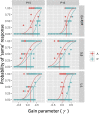Investigating distortions in perceptual stability during different self-movements using virtual reality
- PMID: 35946126
- PMCID: PMC9478599
- DOI: 10.1177/03010066221116480
Investigating distortions in perceptual stability during different self-movements using virtual reality
Abstract
Using immersive virtual reality (the HTC Vive Head Mounted Display), we measured both bias and sensitivity when making judgements about the scene stability of a target object during both active (self-propelled) and passive (experimenter-propelled) observer movements. This was repeated in the same group of 16 participants for three different observer-target movement conditions in which the instability of a target was yoked to the movement of the observer. We found that in all movement conditions that the target needed to move with (in the same direction) as the participant to be perceived as scene-stable. Consistent with the presence of additional available information (efference copy) about self-movement during active conditions, biases were smaller and sensitivities to instability were higher in these relative to passive conditions. However, the presence of efference copy was clearly not sufficient to completely eliminate the bias and we suggest that the presence of additional visual information about self-movement is also critical. We found some (albeit limited) evidence for correlation between appropriate metrics across different movement conditions. These results extend previous findings, providing evidence for consistency of biases across different movement types, suggestive of common processing underpinning perceptual stability judgements.
Keywords: perception and action; perceptual stability; self-movement; virtual reality.
Conflict of interest statement
Figures




Similar articles
-
Factors associated with dynamic balance in people with Persistent Postural Perceptual Dizziness (PPPD): a cross-sectional study using a virtual-reality Four Square Step Test.J Neuroeng Rehabil. 2021 Mar 25;18(1):55. doi: 10.1186/s12984-021-00852-0. J Neuroeng Rehabil. 2021. PMID: 33766072 Free PMC article.
-
A virtual reality approach identifies flexible inhibition of motion aftereffects induced by head rotation.Behav Res Methods. 2019 Feb;51(1):96-107. doi: 10.3758/s13428-018-1116-6. Behav Res Methods. 2019. PMID: 30187432
-
Scene-relative object motion biases depth percepts.Sci Rep. 2022 Nov 2;12(1):18480. doi: 10.1038/s41598-022-23219-4. Sci Rep. 2022. PMID: 36323845 Free PMC article.
-
Using visuo-kinetic virtual reality to induce illusory spinal movement: the MoOVi Illusion.PeerJ. 2017 Feb 22;5:e3023. doi: 10.7717/peerj.3023. eCollection 2017. PeerJ. 2017. PMID: 28243537 Free PMC article.
-
Afferent input, efference copy, signal noise, and biases in perception of joint angle during active versus passive elbow movements.J Neurophysiol. 2007 Sep;98(3):1140-54. doi: 10.1152/jn.00162.2007. Epub 2007 Jul 5. J Neurophysiol. 2007. PMID: 17615137
Cited by
-
The Effects of Visual Behavior and Ego-Movement on Foveated Rendering Performance in Virtual Reality.SN Comput Sci. 2025;6(4):386. doi: 10.1007/s42979-025-03885-7. Epub 2025 Apr 15. SN Comput Sci. 2025. PMID: 40248279 Free PMC article.
References
LinkOut - more resources
Full Text Sources

